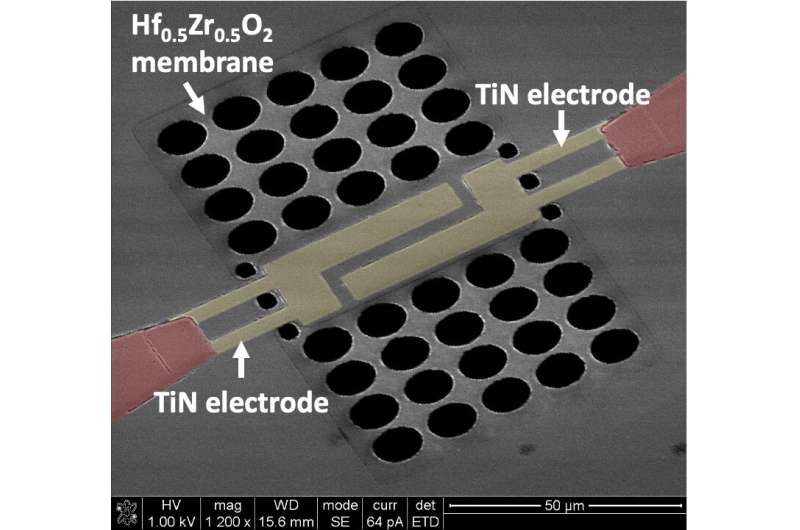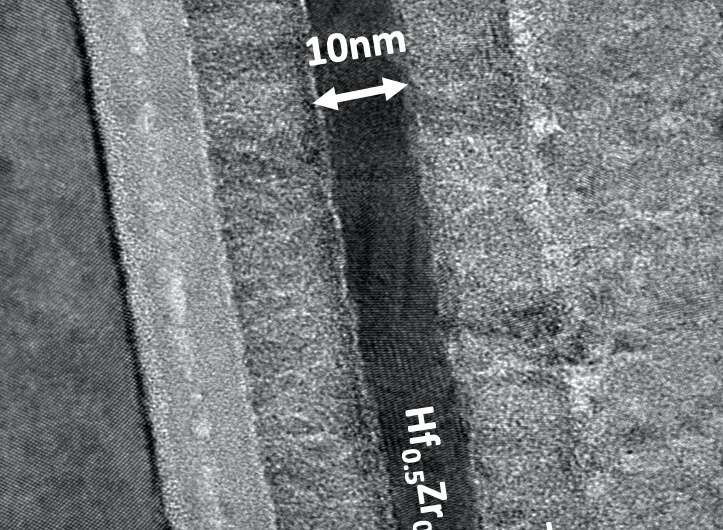October 28, 2019 feature
An ultrathin nanoelectromechanical transducer made of hafnium zirconium oxide

Recently developed nanomechanical resonators that can operate at super-high (i.e., three to 30 GHz) and extremely high (30 to 300 GHz) frequency regimes could be extremely valuable for the development of more advanced semiconductor electronics such as wideband spectral processors and high-resolution resonant sensors. Integrated nanoelectromechanical transducers could enable the development of very small sensors and actuators to facilitate mechanical interaction with the outside world at the atomic level with ultra-high resolution. However, realizing integrated electromechanical transduction at the nanoscale has so far proved to be very challenging.
In a recent study published in Nature Electronics, researchers at the University of Florida were able to fabricate an ultrathin nanoelectromechanical transducer using 10-nm-thick ferroelectric hafnium zirconium oxide (Hf0.5Zr0.5O2) films. The team includes two senior researchers, Roozbeh Tabrizian and Toshikazu Nishida, as well as students Mayur Ghatge and Glenn Walters.
"Our research has followed the long-standing quest in semiconductor sensors and actuators communities for truly integrated nanoelectromechanical transducers," Tabrizian, the lead researcher on the study, told TechXplore. "Nanoelectromechanical transducers facilitate harnessing high-frequency and high-quality factor (Q) mechanical resonance dynamics in semiconductor nanostructures to realize monolithically integrated frequency references and wideband spectral processors at centimeter- and millimeter-wave regimes."
Over the past decade or so, researchers started realizing micro-electromechanical systems (MEMS) for both physical sensing and actuation purposes using piezoelectric transducer films. These thin-film transducers have considerable integration merits compared to other electromechanical transduction schemes such as optical and magnetic solutions. For instance, they enable chip-scale access to mechanical components, which is of vital importance for many practical applications of MEMS, including frequency reference generation, spectral processing, and high-resolution sensing.
"A substantial problem with conventional transducer films, however, are their fundamental scaling limitations," Tabrizian explained. "For example, aluminum nitride films that are widespread in RF filters used in today's mobile phones require a thickness in the range of few 100s of nanometers to yield the required crystalline texture for efficient electromechanical transduction. Further shrinking of the film thickness drastically reduces the electromechanical transduction efficiency and prevents the transducer from detection or induction of vanishingly small motions at the nanoscale."
The hafnium zirconium oxide-based films developed by Tabrizian and his colleagues have significant advantages over more traditional transducer films. For instance, they can be engineered, at an atomic level, to yield efficient electromechanical transduction at few nanometers thickness.

This important feature is a result of a unique characteristic of the atomic-layered hafnia that they used to fabricate the films, which possess meta-stable crystalline phases with ferroelectric properties. When the film is scaled to a few-nanometers, these phases can be stabilized using atomic engineering techniques, such as doping and stacking.
"Atomically engineered hafnia-based films have recently emerged as a new class of ferroelectrics with high potential to realize ultra-low-power and extremely miniaturized non-volatile memory units," Tabrizian said. "In this work, for the first time, we are exploiting the electrostrictive effect observed in super-thin ferroelectric hafnium zirconium oxide (Hf0.5Zr0.5O2) to realize high frequency and high Q nano-mechanical resonators."
In their study, the researchers integrated their ultra-thin nanoelectromechanical transducers into silicon and aluminium nitride membranes, achieving resonators with frequencies ranging between 340 kHz and 13 GHz and a record-high frequency-Q product of 3.97×1012.
"Our demonstration places the atomically engineered hafnia-based transducer as the world's thinnest to enable integrated nano-mechanical resonators," Tabrizian said. "The resonators we developed highlight the feasibility of extreme scaling of integrated nano-mechanical resonators to mm-wave regime."
The ultrathin integrated nanoelectromechanical transducer fabricated by Tabrizian and his colleagues opens up new exciting possibilities for the development of new devices for precision sensing, reference generation, spectroscopy, and wireless communication. Specific applications that could benefit from mm-wave integrated nano-mechanical resonators include ultra-wideband chip-scale filters for emerging wireless technologies (i.e., 5G and beyond), chip-scale transducers for room-temperature quantum sensors, and chip-scale extremely-high-frequency sources for spectroscopy.
"We are now exploring the frequency scaling limits of the hafnia-based nanomechanical resonators and development of atomic engineering techniques to surpass such limits," Tabrizian said. "We are specifically interested in understanding the electrical and mechanical energy dissipation mechanisms and nonlinear scattering dynamics in hafnia films at mm-wave frequencies."
More information: Mayur Ghatge et al. An ultrathin integrated nanoelectromechanical transducer based on hafnium zirconium oxide, Nature Electronics (2019). DOI: 10.1038/s41928-019-0305-3
© 2019 Science X Network















